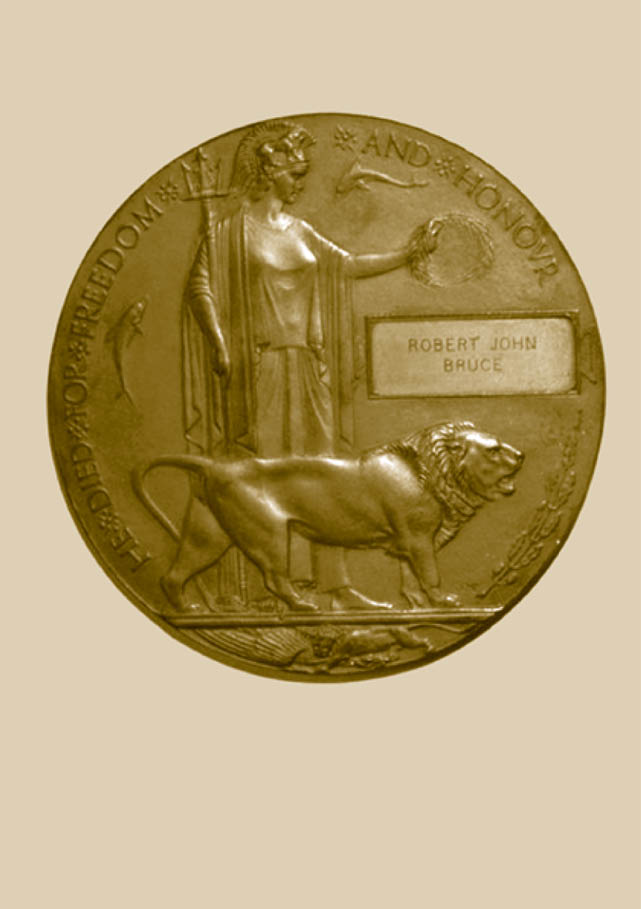
Dead Man’s Penny
by Ken Wright
Somewhere amongst the vandalised graves, rusted wrought iron railing and a handful of empty beer bottles, is the final resting place of Private Robert John Bruce of C Company 46th Battalion, Australian Imperial Forces. His grave in the Will Will Rook cemetery located in Melbourne’s outer suburb of Broadmeadows is impossible to find, as many graves have disappeared following years of wanton destruction and indifference about the historical significance of the cemetery.
Private Bruce was wounded at Pozieres on 4th August, 1916 and after eight weeks in hospital returned to fight at Bullecourt, Ypres and was invalided home on 18th September, 1917. Unfortunately, he died of war related injuries on 21st November 1918, aged 33. His parents, John and Mary Bruce, laid their son to rest with due reverence and the knowledge that he had made the supreme sacrifice for King and Country. A grateful British Government sent his parents – the next of kin – a memorial death plaque, which troops commonly call the ”Dead Man’s Penny”.
The concept of the Dead Man’s Penny began in 1916 when the British government realised that an official token of gratitude should be given to the bereaved next of kin of fallen servicemen and women. The enormous casualty figures that could not have been anticipated at the start of WWI back in 1914 prompted this gesture of recognition. In 1917, the government announced a competition to design a suitable plaque with a prize of £250. There were 800 entries from all over the Empire, the Dominions, and even from the troops on the Western Front. Mr E. Carter Preston of Liverpool, England was the winner.
The selected design was a 12-centimetre disk cast in bronze gunmetal, which incorporated: an image of Britannia and a lion, two dolphins representing Britain’s sea power and the emblem of Imperial Germany’s eagle being torn to pieces by another lion. Britannia is holding an oak spray with leaves and acorns. Beneath this was a rectangular tablet where the deceased individual’s name was cast into the plaque. No rank was given as it was intended to show equality in their sacrifice. On the outer edge of the disk were the words “HE DIED FOR FREEDOM AND HONOUR”.
A scroll, 27×17 centimetres, made of slightly darkened parchment headed by the Royal Coat of Arms accompanied the plaque with a carefully chosen passage written in old English script.
He whom this scroll commemorates was numbered among those who, at the call of King and Country, left all that was dear to them, endured hardness, faced anger, and generally passed out of sight of men by the path of duty and sacrifice, giving up their own lives that others may live in freedom. Let those who come after see to it that his name be not forgotten.
Beneath this passage, written in the same style, was the name, and rank and service details of the deceased. To accompany the scroll, again in old English script, was a personal message from King George V.
I join with my grateful people in sending you this memorial of a brave life given for others in the Great War. George R I.
The plaques were packaged in stiff cardboard folded like an envelope and sent to the next of kin. Production of the plaques and scrolls, which was supposed to be financed by German reparation money, began in 1919 with approximately 1,150,000 issued. They commemorated those who fell between 4th August, 1914 and 10th January, 1920 for home, Western Europe and the Dominions. The final date for the other theatres of war or for those died of attributable causes was 30th April, 1920.
Unfortunately, the production and delivery of the plaques was not a complete success and the scheme ended before all the families or next of kin received these official tokens. There were some relatives who returned the pennies to the Australian government in protest as they felt it was insulting and did not replace their loved one’s life. Of course, nothing can replace a life lost. Nonetheless, the “Dead Man’s Pennies” in private or public collections, museums and national archives, are a constant reminder of the ultimate price paid by the men and women of the armed services during the Great War of 1914—1918.
